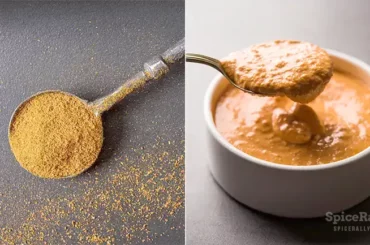Highly palatable apple cider vinegar and red wine vinegar have their own ways of adding flavor to your dishes. But, there must be instances where you tend to confuse the two, failing to understand how they really differ. Thus, here’s an episode that’ll bring everything you need to know about apple cider vinegar vs red wine vinegar.
The main difference between apple cider vinegar and red wine vinegar is the sources they come from. Red wine vinegar is basically fermented red wine, while apple cider vinegar is produced from raw apple juice/apples. In fact, the base ingredients are two different fruits- apples and grapes. Accordingly, their flavor profiles, colors, pH levels, etc., differ significantly.
So, continue reading if you need to know more differences between these two types of vinegar.
Apple Cider Vinegar vs Red Wine Vinegar
| Apple Cider Vinegar | Red Wine Vinegar | |
|---|---|---|
| Core Ingredients | Apples/ apple juice | Wine grapes |
| Other Ingredients | Sugar Water Yeast | Sugar Water Vinegar culture (vinegar mother) |
| Color | Has an amber color and is murky and paler than red wine vinegar. | The color can range from pinkish to dark maroon. Translucent and darker than apple cider vinegar. |
| Key Usages | – In cooking and baking (salads, salad dressings, pickles, cakes, caramel candies) – To preserve food – Household uses (as an all-purpose cleaner, a deodorizer, to trap fruit flies, a weed killer, etc.) – To use as a skincare product (works as a facial toner, reduces acne, removes warts, etc.) – Used for health purposes (lower blood sugar, as a fat-burning drink, as a mouthwash, treats sore throat, etc.) | – Popular in French cooking. – Primarily used to make salad dressings, vinaigrettes, marinades, as a sprinkle over fish and chips, sauces, etc. – To preserve food. – For health purposes (lowers blood sugar levels, protects skin, encourages weight loss, improves heart health) – Promotes skin care (functions as a facial toner to restore the pH level, soothes skin when incorporated in the bath with Epsom salt) |
| Mode of production | Commercial and homemade | Mainly made commercially |
| Availability | – Usually comes in plastic or glass bottles – Can be bought from supermarkets, grocery stores, and online shopping sites | – Typically comes in glass or plastic bottles. – Available in grocery stores, supermarkets, and can be bought from online sellers. |
| Type of acid | Acetic acid | Acetic acid |
| Level of acidity | 5% – 6% | 6% |
| Flavor profile | Mellow and tart with a robust apple flavor | Fruity, very sour, astringent with potent tanning notes. |
| pH Level | 3.3 – 3.5 | 2 – 3 |
| Nutritional Value | – Raw, unfiltered, organic apple cider vinegar is rich in vitamins, probiotics, and minerals. – Therefore, apple cider vinegar is supposed to be high in nutrition when compared with red wine vinegar. | – The quality of red wine vinegar depends upon the quality of red wine used. – However, this contains polyphenols which can have possible health benefits. But, it is not as nutritious as apple cider vinegar. |
More Insights To Apple Cider Vinegar vs Red Wine Vinegar…
Both of these types of vinegar can bring uniqueness to any dish they are called for. But, they are not the same, even if they contain the term “vinegar”.

However, apple cider vinegar has a direct processing method, while red wine vinegar is more like a byproduct of red wine most of the time. In fact, apple cider vinegar is made by extracting raw apple juice directly. At the same time, red wine is often left to ferment into red wine vinegar with a vinegar culture in it.
Both of them can be used interchangeably in many dishes like salads, meat, and soups. In addition, they can replace each other, particularly in marinades, salad dressings, and vinaigrettes.
Wrapping Up…
So, this is all you need to know about apple cider vinegar vs red wine vinegar. Thus, as you see, both of these are comparable in their level of acidity and have similar uses in cooking. But they have notable differences when it comes to their flavor and color.




